As you design your new kitchen, or perhaps as you shop around for a new home, you wonder what is standard for the distance between your countertop and the upper cabinets. Well, in this post, we gather up-to-date research from around the web to thoroughly answer your questions.
The standard height between countertops and upper cabinets is 18 inches. However, for many reasons, it is not uncommon to find cabinets anywhere that is 18 inches above the counter. Reasons for this variability include:
You are watching: How Much Space Between Countertop And Upper Cabinets?
- Height of users
- Height of countertop
- Ceiling height
- Range/oven location
- Design goals
- Personal preference
Keep reading the rest of this post for a rundown on each of the above bullet points. This guide provides an excellent framework to help you make an informed cabinet height decision that you will be happy with for years to come. To conclude, we answer several questions related to the topic of this post.
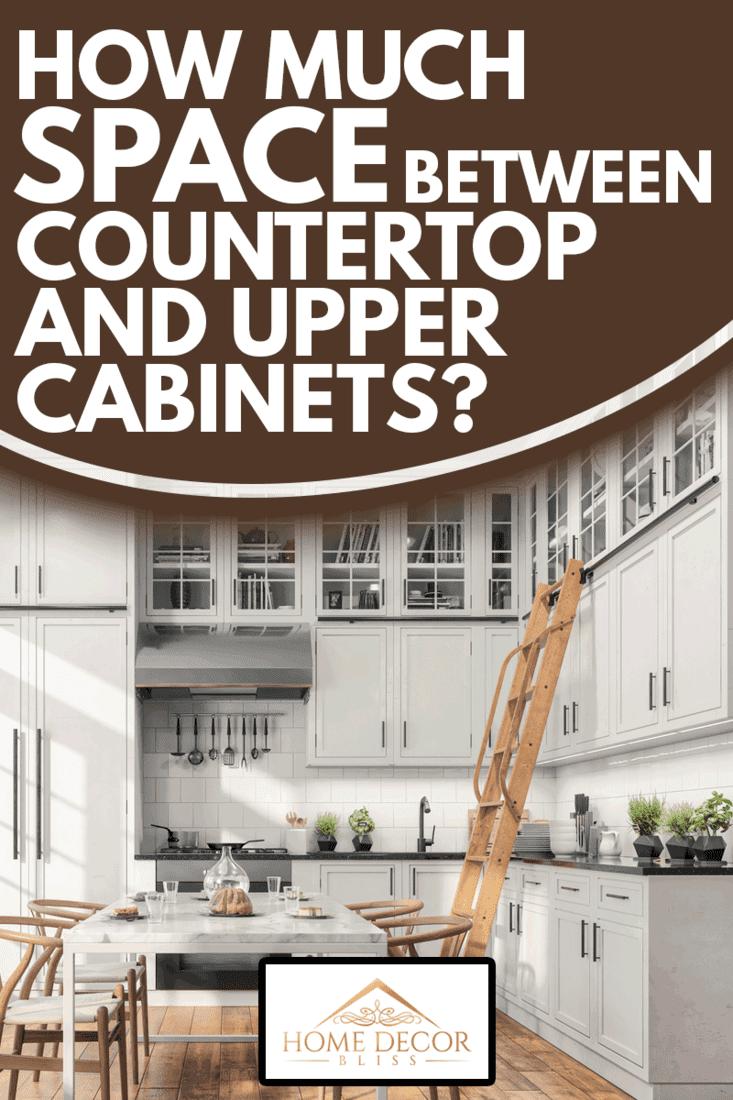
Cabinet Height Considerations
If you are unsure what height is best for you, choosing the standard 18 inches is a safe bet. However, read the following subsections if you want to specifically design the cabinet height above the countertop to suit your needs and preferences.
Height of Users
The final user of the kitchen is the most important single consideration when deciding where to place upper cabinets. For example, while higher upper cabinets are currently in style, this design choice is an ergonomic disaster for shorter family members.
That is to say, you want to place the cabinets high enough above the counter to make counter use easy and convenient but low enough that kitchen users can reach all of the kitchen storage space the cabinets provide.
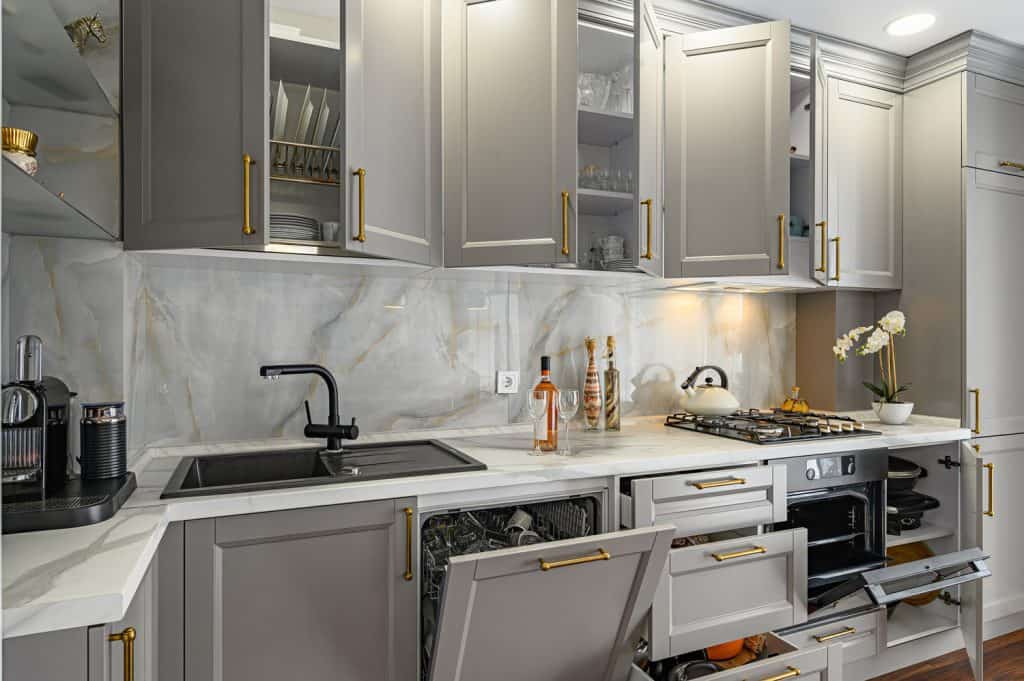
Cabinet placement can also be inappropriate for taller kitchen users. If the upper cabinets are deep enough, they will stick out into the sightlines and working area for taller cooks. Taking a tour of homes with different cabinet heights or discussing this issue with a design expert is very helpful in making an informed decision.
Height of Countertop
The standard height for countertops is about 36 inches. However, this varies based on many reasons, including the age and design standard of the home.
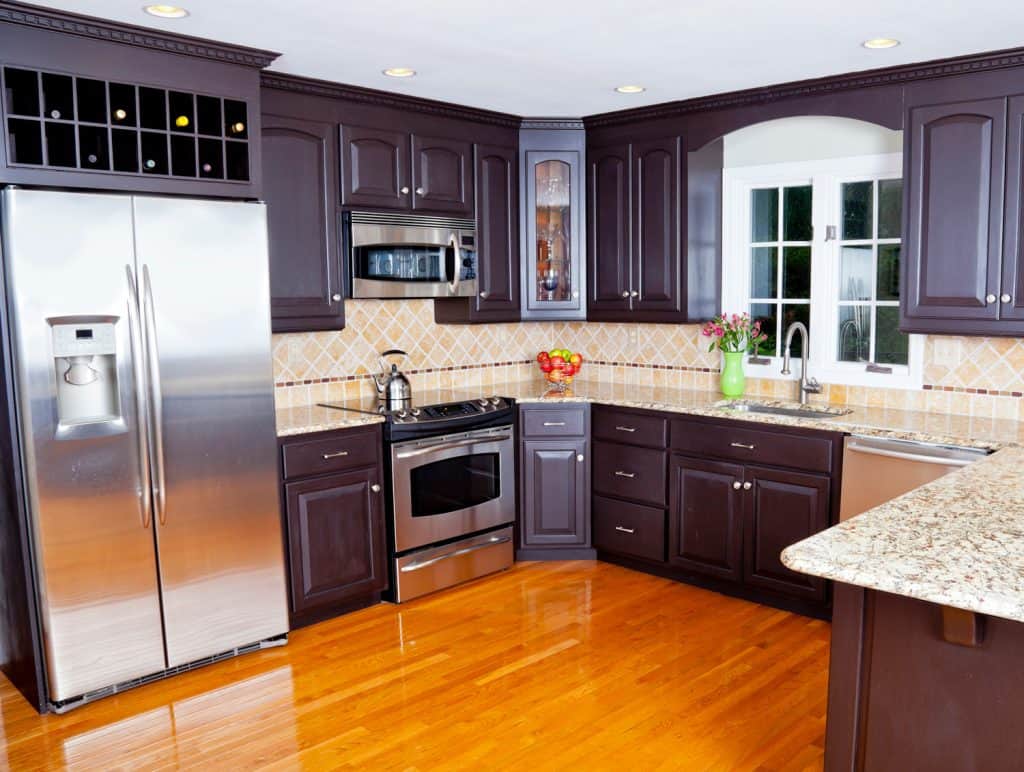
The height of the countertop is important to consider because sometimes you will find oddly high or oddly low counters. In this case, you do not want to automatically install your cabinets 18 inches above the counter. This might make the cabinets awkwardly high or awkwardly low when it comes time to use the kitchen.
Instead, consider the end-users of the space and the countertop height together when deciding on kitchen cabinet placement.
Ceiling Height
Ceiling height, like countertop height, plays a limiting role in where you can place your cabinets. For instance, if you have lower ceilings and taller cabinets, you might need to leave less space above your counters to accommodate the cabinets.
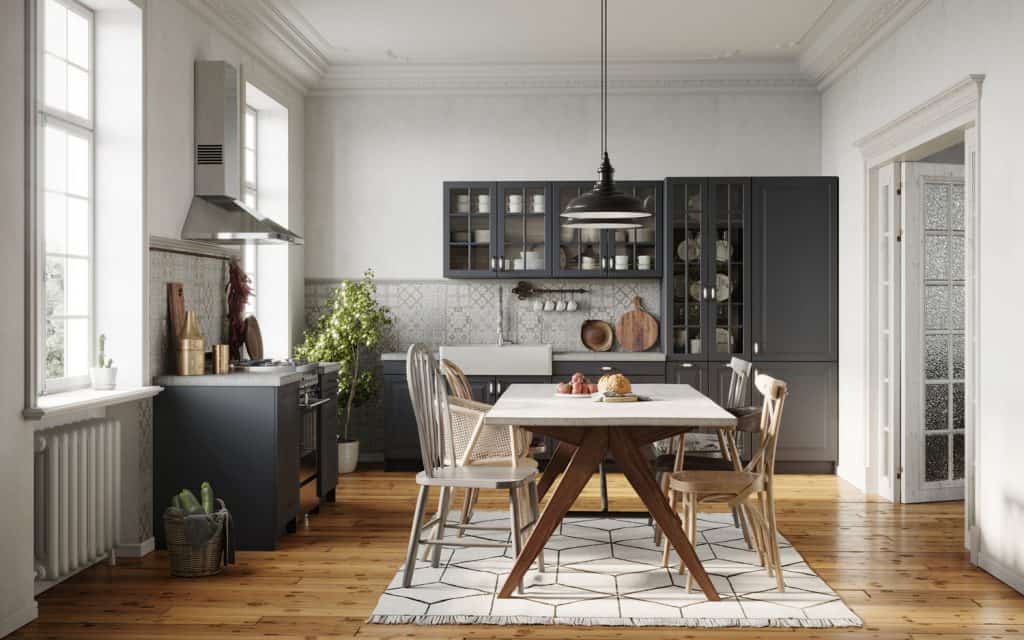
On the other hand, if you have very tall ceilings, it might make the most sense to raise your cabinets a little to more fill the space and give the room a more even look. In short, take into account the whole room height when deciding where you would like your above-counter cabinets placed.
Range/Oven Location
There are code requirements for how high cabinets can be above ranges and or ovens. These are to prevent the risk of fire and other hazards. Often, installing a range hood changes the height requirements.
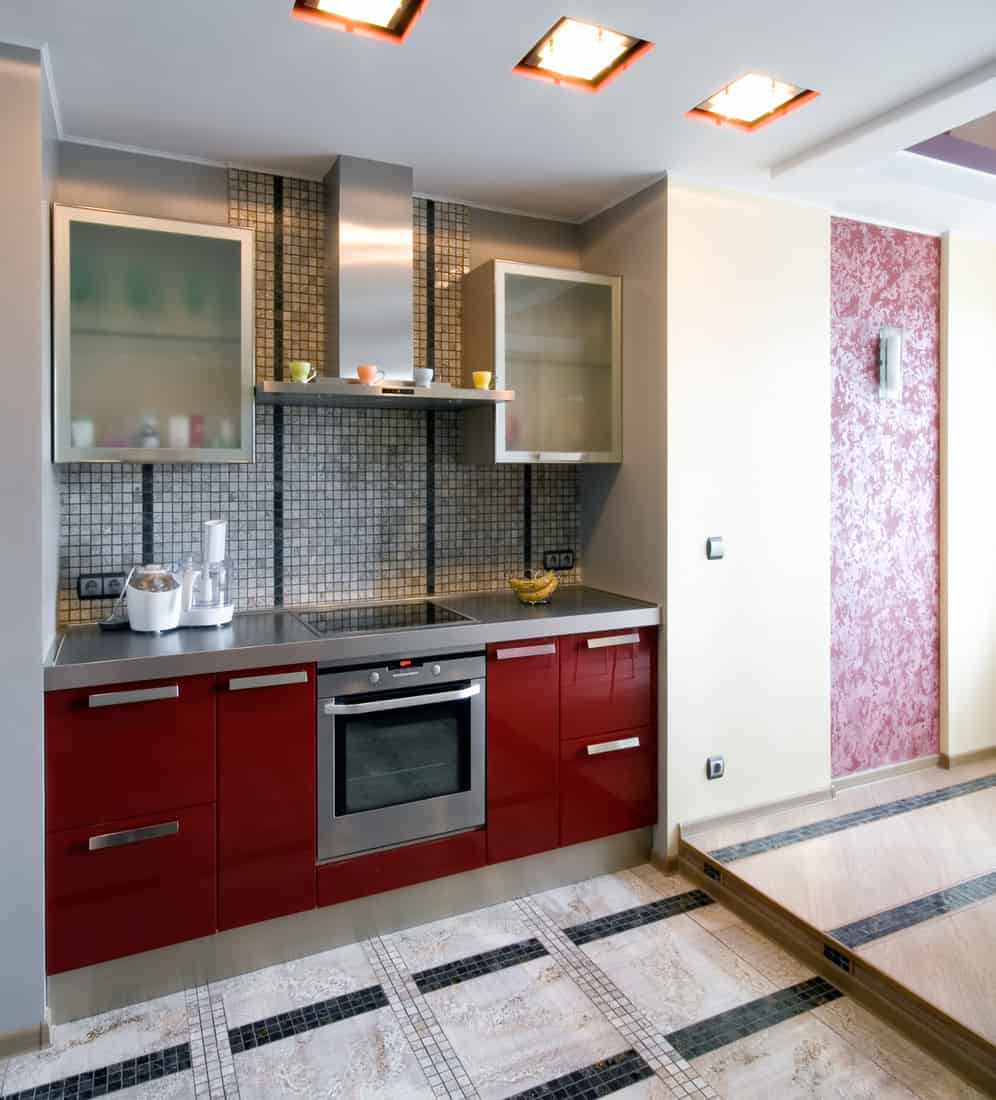
Read more : How To Protect The Finish Of Your New Quartz Countertop
Before installing or designing cabinets above a range or over, be sure to check the local building code. These codes vary from state to state and even municipality to municipality. Your contractor or local architect will also be familiar with the code requirements.
Design Goals
Another consideration when choosing the height of your kitchen cabinets is your overall design goals. For instance, the current aesthetic is to place the cabinets closer to 20 to 24 inches above the counter. This provides more light and a more open feel to the kitchen.

Further, it is usually a priority to match cabinetry throughout the home. To achieve this, you might want to adjust your kitchen cabinet heights to align with cabinets in bathrooms, laundry rooms, and other rooms throughout the house.
Personal Preference
Finally, personal preference is the end-all-be-all of almost all home design choices. If you like cabinets closer to the counters, then, by all means, install them there. Or, if you want cabinets farther from the counters and to use a stool to reach the top shelves, that is your prerogative.
In short, take into account the use of the kitchen, the current height limitations, and your personal preference/design goals to choose your kitchen cabinet height.
Related Questions
Reading the following subsection will provide you savvier when it comes to designing the perfect kitchen.
Are upper cabinets a standard size?
There is no exact standard size for upper cabinets. It is common for them to be between 12 inches and 24 inches deep. Most often, they are about 24 inches wide. In terms of height, they range from about 30 inches to over 50 inches, depending on the size of the kitchen.
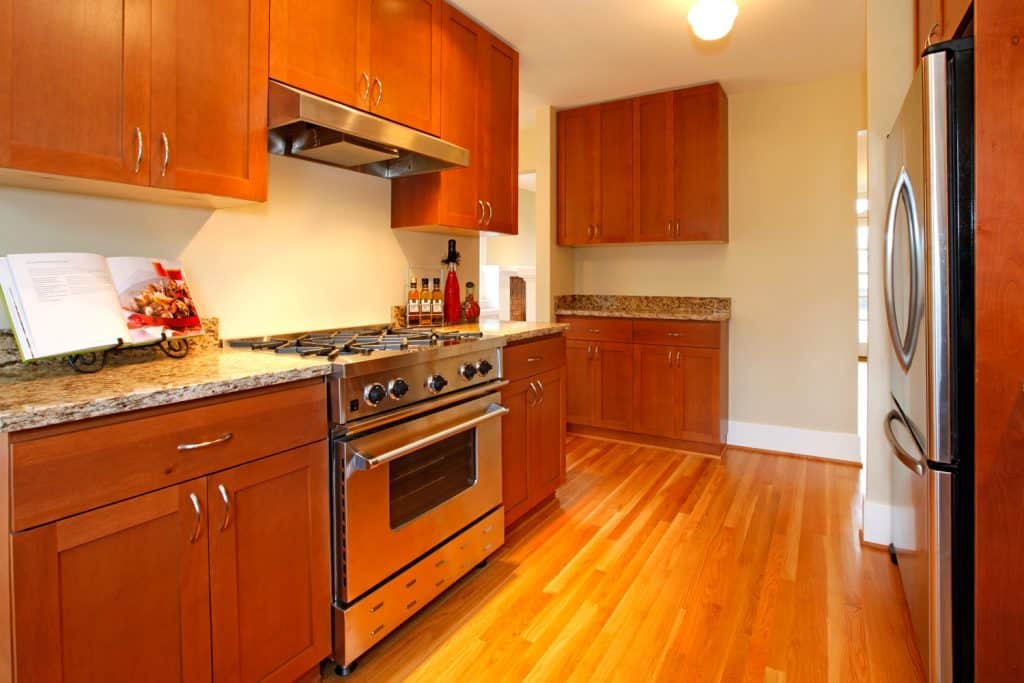
Perhaps, a 12-inch deep by 36-inch tall by 24-inch wide cabinet is most standard. Read this article from Cabinet Select to learn how they determine standard cabinet height.
How do you measure for upper cabinets?
Measuring for upper cabinets can be a very simple to rather complicated process depending on what stage of the build you are in. If you are just adding upper cabinets to an existing kitchen, the process is relatively simple. However, measuring for upper cabinets in a totally unfinished or sketch-up kitchen is much more complicated.
For a primer on kitchen cabinet layout and measuring, check out this article from Best Online Cabinets.
Measuring for Just Upper Cabinets
To measure for just upper cabinets, you have the advantage of already having all the appliances and countertops in place. This makes laying out the centers, sides, and bottoms of the cabinets much easier.

Click here for a tried and true tape measure from Amazon.
Simply determine the size you have to work with, and then order cabinets to fit that space. Sometimes, you might want to order premade cabinets that have fewer size choices. For instance, if you have a 26″ space, you might have to order a 24″ cabinet to fit in that space.
Generally, you will need to measure the height, width, and depth of all cabinets to make informed purchasing decisions.
Measuring for Upper Cabinets without a Completed Kitchen
Measuring for upper cabinets without a completed kitchen is similar to the above steps. However, you will first need to lay out the appliances, countertop, and other kitchen elements. Use a tape measure and a straight line to mark out where all of these elements will be on the walls.
Once you have the elements marked out, you can measure so your kitchen cabinets will be properly spaced from all the other features of your kitchen. This step is also possible by using a graph or drafting paper and mocking up your kitchen as a sketch.
What do you put under the upper cabinets?
Read more : Is Tap Water Safe To Drink?
There exists a wide range of options for what to put under upper cabinets. Often, people choose to leave the space empty so that they can use the space for plug-in appliances and cooking.
Options for what to put under upper cabinets include lighting, outlets, a small shelf, a backsplash, semi-permanent appliances, mug hooks, a paper towel holder, small cutter board shelves, knife magnets, and much more.
How much of a gap between the countertop and backsplash?
Generally, contractors leave about 1/8 of an inch between the countertop and the backsplash. This space allows for silicon caulk or grout to be applied. These materials help seal the area from inevitable water and other spills. If you make the gap too small or too big, these sealants will not adhere as easily and will have less longevity.
Should I paint the underside of the upper cabinets?
There are pros and cons to painting the underside of your upper cabinets. These are discussed in the following two subsections:
Advantages of Painting Underside of Upper Cabinets
By painting the underside of your upper cabinets, you give your kitchen a more complete and finished look. This provides a nicer atmosphere and a higher resale value for your home. If you are already paying a professional painter to paint your kitchen, definitely consider painting all surfaces of your upper cabinets.
Disadvantages of Painting Underside of Upper Cabinets
Cons of this job include the difficulty, the risk of peeling, old grease buildup, and the material of your cabinets. It is harder than it looks to paint under your cabinets without making a mess on the counter and elsewhere. Further, the heat, steam, and smoke from a normal kitchen may cause the paint to eventually peel, which is unsightly.
Also, certain cabinets, such as laminate cabinets, are not super simple to paint and may reject the paint that you are trying to apply. Finally, you will need to clean all grease buildup from the underside of the cabinets before painting. In short, this job is more difficult than it seems but is usually worth the effort if done right.
Read this post to learn how to clean undercabinet grease: 6 Best Degreasers For Kitchen Cabinets Before Painting
And read this article to learn some tricks for even cabinet painting: How To Get A Smooth Finish When Painting Kitchen Cabinets
Can you have a kitchen without upper cabinets?
Yes, you can. While a kitchen with upper cabinets has less immediate storage, the whole space will feel more open and lighter. This is usually possible if you have a large nearby pantry to store all the items required for a functioning kitchen.
In Closing
In this post, we answered the question of how high upper cabinets should be above the counter. We cover all the major considerations for this decision and answer several related questions. Good luck!
FAQs
What are the two most used heights of upper kitchen cabinets?
The two most common heights for upper kitchen cabinets are 30 inches and 42 inches.
What is the ideal height between counter and upper cabinets?
The ideal height between countertops and upper cabinets is typically 18-20 inches.
How high should cabinets be for a 10 foot ceiling?
Typically, the top of the cabinets should be about 18 inches below the ceiling. This leaves a 12-inch gap between the ceiling and the top of the cabinets.
How high should cabinets be for an 8 foot ceiling?
Cabinets should be installed no higher than 54 inches from the floor for an 8 foot ceiling.
Source: https://gardencourte.com
Categories: Kitchens


